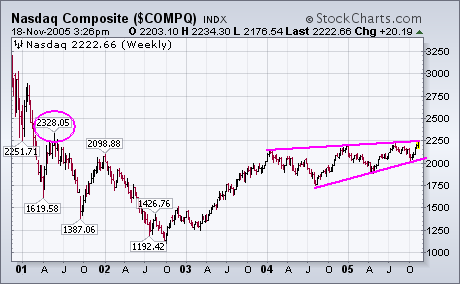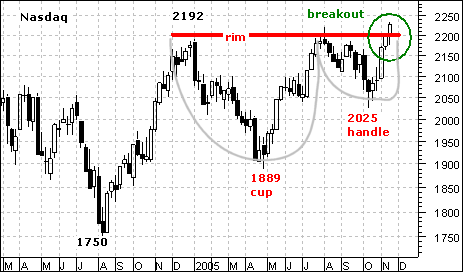This week the markets have started pushing into bullish territory. John, Carl and Arthur all dig into these new events in more detail, but first let's have a look at the S&P 500 Index:

The blue arrow shows where the latest close, just below 1250, has broken the upper line on the 52-week (260 day) price channel - which is just a fancy way of showing that it set a new 52-week high. In fact, you have to go all the way back to June 15, 2001 to find the S&P 500 at this same level. Is this the big breakout we've been waiting for? Or is this just a temporary, soon-to-be-corrected oversold market condition? Even though it is a short week for the US markets, some important signals should appear - stay tuned!
The chart below shows the Nasdaq Composite having hit a new four-year high this week. It's now trading at the highest level since the spring of 2001. There's another shelf of potential resistance to watch at 2328 (see circle), but the action has been impressive. That also continues the trend of higher lows and higher lows that started in the fourth quarter of 2002. Some of our readers have asked, however, about a price pattern that's been forming since the start of 2004 that's marked off by the two converging trendlines shown on the chart.

The Nasdaq’s breakout at 2200 confirms a bullish cup-with-handle pattern and targets a move to around 2500. Until there is evidence to the contrary, this is the dominant chart pattern and further gains should be expected.
William O’Neil of Investor’s Business Daily (IBD) developed the cup-with-handle pattern. It is a bullish continuation pattern that marks a corrective period followed by a minor pullback and a breakout. Looking at the Nasdaq chart, I think the characteristics of a bullish cup-with-handle are present. First, there was a sharp advance from 1750 to 2192. This established the uptrend. Second, there was a decline to 1889 and then another move to resistance around 2200. This correction formed the cup and established rim resistance. Third, the index pulled back to 2025, formed a higher low and then surged above resistance at 2200 over the last few weeks. This mild correction formed the handle and the breakout confirmed the pattern. The depth of the cup is added to the breakout for an upside projection. This breakout is bullish and should be treated as such until proven otherwise.
What would it take to prove this breakout otherwise? The breakout should hold and a move back below 2200 would be negative. However, I would not give up on the pattern on the first sign of weakness. It would take a failure at resistance AND a break below the handle low at 2025 to fully reverse the current uptrend and turn bearish.

When a stock is above a moving average it is considered bullish, and the stock can be considered to be in a rising trend for that time frame. A good way to determine the market's overall condition (overbought/oversold) across a range of time frames is to analyze the percentage of stocks above their 20-, 50-, and 200-day moving averages. The following chart shows the condition of the stocks in the S&P 500 Index.

As you can see the market is becoming overbought in all time frames. Each of the three indicators is not only approaching the top of its trading range, but they are very close to the declining tops lines I have drawn, which demonstrates how participation is fading even as the S&P 500 moves to progressively higher tops. If the indicators can press higher to about the 90% level, it would be a longer-term positive; however, if the declining tops lines prevail, it is likely that overhead resistance on the price index will force another correction.
I am seeing this kind of picture through a wide range of internal indicators, and investor sentiment is becoming extremely bullish, so I expect that there will soon be another correction of sufficient depth and duration to clear the overbought condition and dampen confidence. As you can see from other corrections in the last few years, this can be accomplished fairly quickly and painlessly.